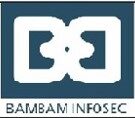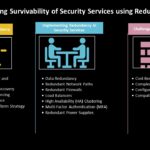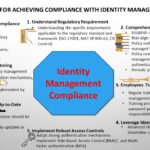
In today’s cyber threat and evolving technology landscapes, the concept of Zero Trust Architecture (ZTA) has emerged as a paradigm shift; emphasizing a never-trust, always-verify approach. ZTA represents a fundamental shift away from the traditional perimeter-based security models toward a more comprehensive and dynamic approach to protecting data and systems. While zero trust principles are gaining traction across industries, implementing them in a cloud computing environment comes with its own set of challenges that require strategic planning and innovative solutions. By proactively addressing these challenges, organizations can build resilient cloud security architecture that enables innovation and drives business success.
The Zero Trust Paradigm: A Brief Overview
Zero trust is based on the principle of “never trust, always verify.” It assumes that threats may exist both outside and inside the network, and therefore, no entity, whether inside or outside the network, should be trusted by default. Instead, every user, device, application, and network resource must be continuously authenticated, authorized, and monitored, regardless of their location or connection method.
Adopting a ZTA offers various benefits for organizations which include but are not limited to adaptability, regulatory compliance, cost-effectiveness, mitigation of insider threats, and reduced attack surface. Despite its benefits, implementing zero trust in a cloud computing environment presents several challenges.
Emerging Challenges of Zero Trust Implementation in Cloud Computing:
Complexity of Cloud Environments:
Cloud environments are inherently complex, with a dynamic infrastructure, diverse workloads, data repositories and interconnected services. Managing and securing these diverse environments while implementing zero trust principles can be complicated.
Integration with Existing Security Controls:
Integrating Zero Trust principles with existing security controls, such as firewalls, intrusion detection systems (IDS), security information and event management (SIEM) solutions and cloud services, is essential for holistic security management. Organizations must ensure compatibility and interoperability between different security tools and platforms to avoid gaps in protection. However, achieving seamless integration and orchestration across heterogeneous environments and disparate platforms can be complex.
Identity and Access Management (IAM):
Establishing and maintaining granular control over user identities and access privileges is a cornerstone of the zero trust model. However, managing identities, enforcing least privilege access, and ensuring authentication in a dynamic cloud environment, diverse user groups and third-party applications pose significant challenges.
Legacy Systems and Applications:
Many organizations still rely on legacy systems and applications that may not be compatible with modern zero trust principles. Integrating these legacy systems into a zero trust model can be challenging and may require significant refactoring or replacement.
Visibility and Monitoring:
Maintaining visibility into the cloud environments is critical for enforcing zero trust principles. Organizations must have comprehensive visibility into user and device activities, network traffic, and data flows to detect and respond to threats effectively. However, the dynamic nature of cloud environments and the use of ephemeral resources can make it challenging to achieve comprehensive visibility.
User Experience:
Balancing security requirements with usability is essential to aid widespread adoption and user compliance. Employing ZTA may introduce additional authentication and authorization steps, which can be overly cumbersome and intrusive. Thus, impacting users’ experience and decreasing productivity.
Data Protection and Privacy Concerns:
Securing sensitive data in transit, at rest, and in use is critical for maintaining compliance and mitigating risks. Implementing Zero Trust requires robust encryption, data loss prevention (DLP) measures, and data classification policies that can help mitigate the risk of data breaches. However, data proliferation across cloud services, lack of visibility into data flows, and inadequate encryption mechanisms complicate data protection efforts.
Compliance and Governance:
Cloud environments are subject to various regulatory requirements and industry standards, such as GDPR, HIPAA, and PCI DSS. Navigating the compliance (GRC) framework challenges relating to data protection, privacy and auditability while ensuring that the ZTA implementation aligns with relevant compliance mandates and guidelines can be resource-intensive.
Key Strategic to Overcoming Zero Trust Architecture Implementation Challenges
Comprehensive Risk Assessment:
Conduct a thorough risk assessment to identify assets, vulnerabilities, and potential threats in the cloud environment. The process helps to develop a comprehensive understanding of the organization’s data flows, network, and security requirements. In addition, it helps to prioritize security measures and guide the implementation of zero trust model.
Embrace a Unified and Hybrid Approach
Organizations often operate in hybrid or multi-cloud environments, combining on-premises infrastructure with cloud services from multiple providers. To address cloud complexity, organizations must adopt a unified and hybrid approach to zero trust that spans across all cloud platforms and services. This involves combining traditional network-based controls with cloud-native security solutions. By leveraging cloud-native security solutions and integrating them with existing security tools, organizations can enforce consistent security policies across their entire cloud footprint. Also, this allows organizations to leverage existing investments while gradually transitioning to a Zero Trust Architecture.
Zero Trust Network Access (ZTNA):
Zero Trust Network Access (ZTNA) solutions provide secure access to applications and resources based on identity and context, regardless of network location. By adopting ZTNA, organizations can enforce granular access controls and reduce the attack surface.
User Education and Awareness:
Balancing security requirements with usability is essential to ensure that zero trust measures do not impede legitimate user activities. Users and employees need to be educated about the principles of zero trust and the importance of security best practices. Encourage employees to follow strong authentication methods, practice least privilege access, and report any suspicious activities promptly.
Conclusion
Implementing zero trust in cloud computing environments presents both opportunities and challenges for organizations seeking to enhance their security posture. By addressing the emerging challenges and adopting innovative solutions, organizations can establish a robust zero trust framework that effectively protects data, applications, and infrastructure in the cloud. Ultimately, embracing the zero trust paradigm is essential for staying ahead of evolving cyber threats and ensuring the resilience of cloud-based operations.








